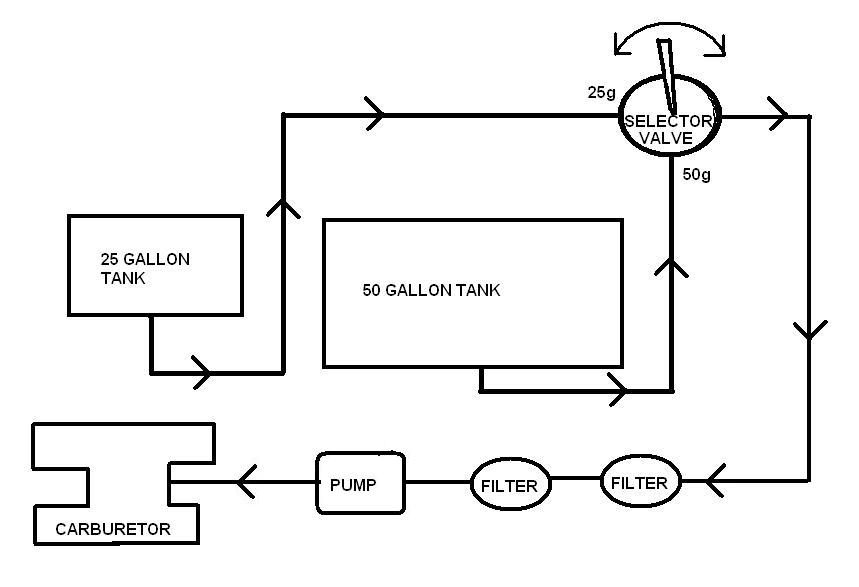I need some solid information about vapor lock in an automobile fuel line.
When I moved down from Alaska, I brought all of my belongings in a 38 year old school bus that I bought for $1.00. (When I finished getting it roadworthy I had spent so much money that I made the guy who sold it to me give me half of my money back!) The bus has a 360 cubic inch Dodge V-8 engine feeding through a single two-barrel carburetor. It has a five speed transmission with a two speed rear axle, and in low gear/low range it would drive straight up a wall if it had enough traction. (Less than walking pace at 2000 RPM)
The bus has a complex fuel system -- dual tanks (25 gallon & 50 gallon) running to a selector valve, and then through two in-line filters and an electric fuel pump to the carburetor. (See diagram.)
If I drive the bus in warm weather (65 degrees or warmer) under load at speeds slower than 20 MPH, it vapor locks and quits. I have about 20 seconds warning that this is happening as the fuel pump is mounted under the floorboards and I can hear it starting to go "thocka-thocka-thocka" when it tries to pump vapor and I have until the float bowl in the carburetor empties to get the bus off the road. Opening the hood and letting excess heat escape for 10-15 minutes makes it work again. The engine is not over-heating; only the fuel system is too hot.
It was always my understanding that vapor lock could only occur on the input side of the fuel pump; that the pump couldn't pump gasoline "steam" and the fuel flow stopped; but that if the fuel were boiling in the output line between the pump and the carburetor the pump would keep pressure in the line and maintain fuel flow even if some of it were boiling.
I am beginning to wonder if this is a misunderstanding on my part.
The fuel lines are well away from any heat source, from the fuel tanks all the way through the selector valve, fuel filters, and fuel pump. From the pump to the carburetor is a different story -- the steel line is uncomfortably close to the exhaust manifold and exhaust pipe. Logically that is the most likely place for the fuel to boil. Arguing against that is the line should be pressurized, and usually when it vapor locks it is during a high fuel flow situation (crawling up a steep hill at maximum throttle in third gear low range at 15-20 MPH) so the fuel shouldn't spend enough time in the hot fuel line to boil. Also arguing against the boiling being on the output side of the pump is the fact that the pump is going "thocka-thocka-thocka" which strongly suggests that it is not receiving fuel from the input side. But the input side is not subject to much heat...
So, I don't know what is going on. Symptoms point to vapor lock on the input; logic points to vapor lock on the output side; [possibly faulty] knowledge says output side vapor lock shouldn't happen.
If somebody out here in bbs-land really knows and understands vapor lock from hands-on experience (lastdan, are you listening? It's been 10 months since we heard from you) I would love to hear from you.
tanstaafl.
Attachments

_________________________
"There Ain't No Such Thing As A Free Lunch"

